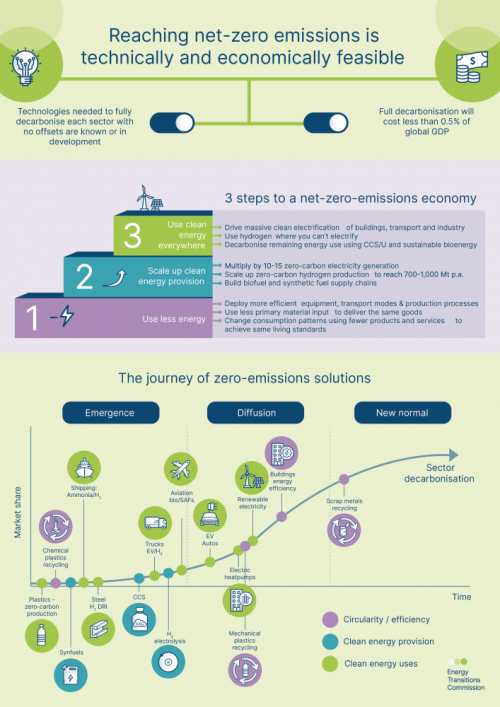
https://www.energy-transitions.org/publications/making-mission-possible/
From the executive summary::
https://www.energy-transitions.org/wp-content/uploads/2020/09/Making-Mis...
Using less energy
There are major opportunities to improve the energy productivity by which we turn energy inputs into welfare-enhancing goods and services, reducing energy use while maintaining or even improving living standards. These opportunities lie in three areas
:• Energy efficiency: Technical energy efficiency can still be improved across multiple applications in, for instance, transport (eg, more efficient aircraft), industry (eg, reduced energy inputs to traditional blast furnace-based steel production) and buildings (eg, better insulation and higher coefficient of performance in air-conditioning systems). Improvements of up 50% are theoretically possible in the transport sectors; while in industry, more modest but still significant improvements of 10% 20% could be achieved.
• Material efficiency: There are major opportunities to reduce the primary production of energy-intensive materials, such as steel and cement, through product redesign, more efficient material use and greater materials recycling and reuse. In theory, such measures could reduce global emissions from heavy industrial sectors by 40% below business-as-usual level.
• Service efficiency: Finally, it is possible to deliver higher living standards while using less energy-intensive goods and services – for example, via better urban design or shared use models in transport. Here the potential depends on consumer behavior changes and is therefore more speculative; but in principle, major reductions could be achieved. Seizing these opportunities will require major changes to business value chains (eg, in product design, distribution and recycling processes), and in consumption and lifestyle choices (eg, in urban design and mobility systems).
The total amount of final energy needed to support high living standards will also be strongly influenced by how far we can electrify economic activities across each sector of the economy. This reflects the inherent efficiency advantage of electricity in several applications – in particular, road transport and building heating.
Finally, digital technologies have the potential to significantly contribute to these opportunities by offering both end-use and system efficiency benefits: they can facilitate reductions in energy use in many sectors, from construction to manufacturing (eg, 3D printing, lightweighting); better monitoring of and automated responses to efficiency losses across sectors (eg, industrial energy efficiency monitoring, load management in logistics); and enhanced energy demand monitoring and management at the energy system level (eg, vehicle-to-grid, building heating management)










Add new comment